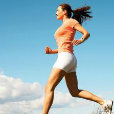New Biochemical Acupuncture Athletic Performance Research
{ 21 mei, 2013 }
New research reveals that acupuncture stimulates the release of biochemicals that relieve athletic fatigue due to intensive endurance exercises. Researchers found that acupuncture applied to specific acupuncture points increases antioxidant activity and decreases biochemical releases that are markers for oxidative stress. The researchers applied electroacupuncture to acupoints on the legs in this randomized, controlled study. The results measured specific results showing that electroacupuncture has beneficial effects on human health by intervening in the free radical metabolism process in athletes.
Acupuncture needling is applied in this image. Acupuncture NeedlingThe endurance athletes received electroacupuncture once a day for 15 days during the training period. The acupuncture point selection included acupoints on the Spleen, Stomach and Liver acupuncture channels: SP10 (Xuehai), ST36 (Zusanli), LV3 (Taichong), SP6 (Sanyinjiao). Acupuncture needle retention time was 30 minutes per acupuncture treatment.
The researchers measured significant increases in superoxide dismutase (SOD) and significant decreases in serum malondialdehyde (MDA) for the endurance athletes. Superoxide dismutases are enzymes that have important antioxidant effects in cells. Superoxide dismutases protect cells from toxicity and exert powerful pharmacological anti-inflammatory responses. Acupuncture successfully increased this important biochemical in the bloodstream for the athletes.
Acupuncture was also shown to lower levels of malondialdehyde, an organic compound that is a marker for oxidative stress. Acupuncture lowers levels of this biochemical responsible for toxic stress in cells. Malondialdehyde is associated with pathologies such as disorders of the cornea and osteoarthritis. The researchers concluded that electroacupuncture decreases MDA and increases SOD in athletes undergoing “intensive endurance exercise, which may contribute to its effect in relieving athletic fatigue.”
The researchers chose two acupuncture points on the Spleen channel. SP10 is located 2 cun above the medio-superior border of the patella, when the knee is flexed, on the bulge of the medial portion of the m. quadriceps femoris. SP10 is given the Chinese Medicine name of Xuehai, translated as the Sea of Blood. According to Traditional Chinese Medicine principles, SP10 harmonizes nutritive Qi and cools heat. SP10 is commonly used by licensed acupuncturists in the treatment of irregular menstruation, amenorrhea, abnormal uterine bleeding, urticaria, eczema, neurodermatitis, pruritis and erysipelas.
SP6 is located 3 cun directly above the tip of the medial malleolus on the posterior border of the medial aspect of the tibia. SP6 has the Chinese Medicine name of Sanyinjiao, translated as Three Yin Junction. SP6 is the meeting point of the three lower Yin channels and has the Traditional Chinese Medicine (TCM) functions of strengthening the Spleen, transforming dampness, spreading the Liver Qi and benefitting the Kidney. SP6 is used by licensed acupuncturists for the treatment of a variety of indications including abdominal pain and distention, diarrhea, dysmenorrhea, irregular menstruation, uterine bleeding, leukorrhea, prolapse of the uterus, sterility, difficult or delayed labor, nocturnal emissions, enuresis, dysuria, lower limb atrophy or motor impairment of the limbs, vertigo from Blood deficiency and insomnia.
ST36 was also used in the study. This acupuncture point is located 3 cun below ST35 and is one finger-breadth from the anterior crest of the tibia in the m. tibialis anterior. This acupuncture point is located lateral to a tibial notch that can be felt upon palpation. ST36 is given the name Zusanli, translated as Leg Three Measures. ST36 is given many functions and indications in the Chinese Medicine system. It is a He Sea, Earth, Lower He Sea Point of the Stomach and Sea of Nourishment Point. ST36 orders the Spleen and Stomach, regulates Qi and Blood and strengthens weak and deficient conditions. ST36 is traditionally used for the treatment of gastric pain, vomiting, abdominal distention, diarrhea, constipation, mastitis, breast abscesses, enteritis, gastritis, edema, asthma, general weakness, emaciation, anemia, indigestion, apoplexy, shock, hemiplegia, neurasthenia and mania.
LV3 was used in this study. LV3 is located on the dorsum of the foot, in the depression distal to the junction of the first and second metatarsal bones. According to Traditional Chinese Medicine theory, LV3 is a Shu Stream, Earth and Source Point. LV3 pacifies the Liver, regulates the Blood and opens the channels. LV3 is used by licensed acupuncturists for the treatment of headaches, vertigo, insomnia, irregular menstruation, abnormal uterine bleeding, joint and extremity pain including arthritis, eye pain, rib pain, retention of urine and enuresis.
Reference:
Liu, J. Y., and L. M. Liu. “[Influence of electroacupuncture intervention on free radical metabolism in athletes undergoing intensive endurance exercise].” Zhen ci yan jiu= Acupuncture research/[Zhongguo yi xue ke xue yuan Yi xue qing bao yan jiu suo bian ji] 38, no. 1 (2013): 48-51.
Rubrieken: Acupunctuur, Opleiding acupunctuur ~ Trackback




Reageer